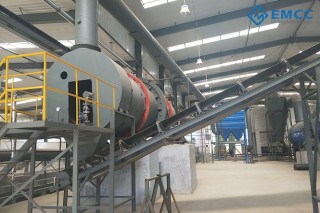Municipal waste treatment, sludge treatment
EMCC has been delivering custom process equipment, process development services, and service support to companies internationally for over 10 years.
MUNICIPAL WASTE TREATMENT, SLUDGE TREATMENT
Urban waste drying refers to the process of drying urban waste to reduce its moisture content and volume. This method is commonly used for wet waste or organic waste to facilitate further processing or disposal.
THE PROCESS OF URBAN WASTE DRYING TYPICALLY INVOLVES THE FOLLOWING STEPS:
Collection and sorting: Collecting and sorting the waste, separating wet waste or organic waste for separate treatment.
Drying equipment: Using specialized waste drying equipment, such as dryers, to dry the wet waste. The drying equipment typically utilizes hot air or thermal energy to evaporate the moisture in the waste.
Control parameters: During the drying process, it is necessary to control appropriate temperature, humidity, and ventilation parameters to ensure drying efficiency and equipment safety.
Drying time: Determining the appropriate drying time based on the moisture content of the waste and the capacity of the drying equipment. Higher moisture waste usually requires a longer drying time.
Post-drying treatment: The dried waste can undergo further treatment such as compression, incineration, composting, or landfilling.
Sludge drying is a method used for large-scale drying of sludge. Sludge drying is commonly employed in the treatment of sludge generated from wastewater treatment plants or industrial wastewater treatment processes.
THE PROCESS OF SLUDGE DRYING TYPICALLY INVOLVES THE FOLLOWING STEPS:
Dewatering: Initially, the sludge is subjected to dewatering to remove a portion of the moisture. Techniques such as filter presses, centrifuges, or belt filter presses are commonly used for dewatering.
Drying equipment: The dewatered sludge is then sent to drying equipment such as dryers. These devices use hot air or thermal energy to evaporate the moisture in the sludge.
Control parameters: During the drying process, it is necessary to control appropriate temperature, humidity, and ventilation parameters to ensure drying efficiency and equipment safety.
Drying time: Determining the appropriate drying time based on the moisture content of the sludge and the capacity of the drying equipment. Higher moisture sludge usually requires a longer drying time.
Post-drying treatment: The dried sludge can undergo further treatment such as compression, incineration, composting, or landfilling.
It is important to note that both urban waste drying and sludge drying require proper control of temperature and humidity during the processing to ensure equipment safety and treatment effectiveness. Additionally, for sludge drying, proper handling and disposal of the dried sludge are necessary to minimize environmental impacts.
RESOURCES

SLUDGE GARBAGE DECOMPOSITION TREATMENT EQUIPMENT
The sludge fertilizer making equipment extracts qualified sludge through solid
